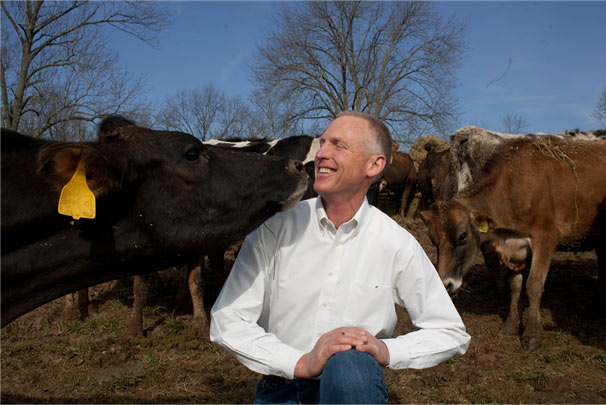Originally published by the Organic & Non-GMO Report
by Ken Roseboro

Snowville Creamery’s Warren Taylor creates model to increase non-GMO feed supply as a way to convert to organic farming and eliminate GMOs.
Snowville Creamery, based in Pomeroy, Ohio is a small dairy operation, but its owner, Warren Taylor, has big ideas. Taylor wants to change the food system—from one based on factory farms and GMOs to one based on local, sustainable, non-GMO, and organic farms and foods. He is starting with his own operation.
Taylor is a career dairyman; he followed in his father’s footsteps and became a dairy process engineer. In his 40-plus-year career, Taylor designed processing plants and systems for companies such as Safeway, Dannon, Land O’ Lakes, and Yoplait. Cut him, and Taylor says he will “bleed white.”
Seven years ago, Taylor left a successful dairy consulting business to start Snowville Creamery. Why? Because he felt that the milk produced today was an inferior, poor-tasting product.
“I was mad at the industry,” he says. “I built a creamery to prove that we can produce good high quality, good tasting milk for everybody in America.”
Applying his engineering knowledge, Taylor wants to produce a model of non-GMO and organic milk production that can be replicated nationwide. I’m not into marketing; I’m a revolutionary and want to change the world,” Taylor says.
Pasture-raised cows
Snowville buys milk from 10 local dairy farms and processes it into milk, cream, and yogurt products. The creamery produces 15,000 gallons of milk per week. Snowville’s dairy products are sold in supermarkets such as Kroger and Giant Eagle and to Whole Foods stores in Ohio, Pittsburgh, PA, Louisville, KY, and Washington, DC. Restaurants in the Columbus and Athens, Ohio areas also use Snowville’s products.
Many of Snowville’s dairy farms raise the brown Jersey cows, which are known to produce milk that contains higher butterfat, lactose, protein, and minerals.
Cows graze on pasture, which makes up about 75 percent of their diet, the rest being grains such as corn, which supply protein.
According to Taylor, pasture-raised cows produce more nutritious milk that is much higher in omega 3 fatty acids and conjugated linoleic acid, essential nutrients for heart and brain function.
It tastes better too. “You can taste the difference of milk from grass fed cows,” he says.
Snowville’s cows graze on pasture 250 days per year, more than double the National Organic Program’s requirement of 120 days for organic dairy cows.
So why doesn’t Snowville just go organic? Taylor, who has heard that question many times, has a ready response.
“Because there is not a sufficient quantity of economically available certified organic feed and forage,” he says. “Organic corn costs about twice whatever commodity corn costs.”
Encouraging farmers to grow non-GMO without chemicals
The feed challenge led Taylor to apply his engineering skills and build his own supply chain, which he believes can be replicated nationwide and could lead to the elimination of genetically modified crops. Taylor chose to source non-GMO corn for feed, which is readily available from Ohio farmers. The non-GMO corn sells for a $.50 per bushel premium above the cost of commodity corn. Taylor offered farmers a $1.00 per bushel premium as a way to encourage them to develop long-term relationships with Snowville. Taylor plans to pay the farmers an additional $.50 per bushel premium each year to encourage them to reduce the use of pesticides and synthetic fertilizers. In this way he is subsidizing the farmers’ transition to certified organic production, which is his ultimate goal.
“In three or four years we are paying $2 or $3 over commodity price, and have created additional organic grain supply for livestock agriculture in Ohio,” Taylor says. “We want to leverage non-GMO into certified organic as quickly as possible. Non-GMO is a bridge.”
Publishes GMO test results on website
Taylor contracted an Amish mill in Wooster, Ohio to process the non-GMO corn and test it for GMOs. He supplied the mill with GMO testing equipment from Envirologix including a Quikscan scanner, computer, and Quickcomb GMO test strips. Taylor developed a protocol with the mill that includes testing, notification to Snowville of test results, and rejection of grains that test above 1.5% GM material.
Snowville publishes the GMO test results on its website for all to see. “I want to be transparent, which is what we all should be doing in the food industry,” Taylor says.
Taylor wanted to label his dairy products as “non-GMO-fed” so he contacted the US Food and Drug Administration, which told him to contact the US Department of Agriculture, which then told him to go back to the FDA. After the government revolving door, Taylor contacted the Ohio Department of Agriculture, which worked with him to develop a label for his products, which reads “From Grass Grazed Cows Fed Only Non-GMO Feeds & Forage.”
Taylor is also putting his products through the Non-GMO Project’s verification program at the request of Whole Foods Market, which wants its suppliers to be verified to meet the company’s GMO labeling requirement by 2018.
Future plans for Snowville include building a local mill to process the feed. Taylor hopes to secure a Slow Money loan to finance the mill. He also received a grant to purchase seeds and work with farmers to grow small grains as feed alternatives to GMO-risk corn.
Taylor sees organic farming and his non-GMO operation as a small but significant step to addressing the big threats posed by chemical intensive GMO agriculture.
“Our approach has the potential to increase the supply to meet the demand, while leading non-GMO feed and forage producers towards certified organic production,” he says. “I’m optimistic we will be able to change the food system.”


